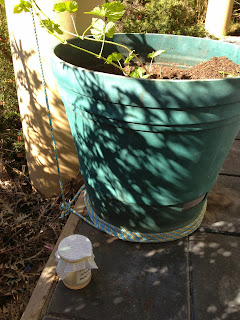Yesterday I brewed my last two candidates for
the competition, a Leichtes Weizen and an Ordinary Bitter. I left these till last because they'll both clock in at under 4% abv and I want them to be as fresh as possible when I send them off.

The
Australian Amateur Brewing Championship guidelines borrow heavily from the American BJCP guidelines but differ at a few important points. The AABC categorises some styles differently so that instead of putting an Ordinary Bitter together with other English Pale Ales as in the BJCP, it gets put in Category 1: Low Alcohol (<4% ABV). That category also contains Leichtes Weizen, a low gravity German wheat beer (OG range of 1.025-1.035).
I've brewed a couple of hefeweizens, a dunkelweizen and a weizenbock but so far I haven't managed to brew a wheat beer that has exactly the combination of wheat, pils malt, clove and banana goodness that I'm after. Hopefully that's all changed now. The Leichtes Weizen was apparently an attempt of the major wheat beer brewers to compete with the 'Lite' beers of the big lager brewers. I don't know how successful this was but it makes for a tricky little beer to brew. It needs to have all the flavours of a Hefeweizen but in balance with each other and turned down a bit to fit in a lower gravity beer. Nothing should stick out, no aggressive cloves, no in your face banana, no hops, no malt dominance. It's a beer designed by removing parts of an existing style rather than built from the ground up.
So in the light of my earlier wheat beer failures, I've attempted to modify my process to hopefully hit the perfect combination. There's nowhere to hide if I've gotten it wrong, it'll be obvious and the judges will mark it down. I decided to try my first ferulic acid rest, probably something I probably should have tried earlier on a non-competition brew. It's a rest in the mashing process at 43C where, thanks to the work of some amazing enzymes, ferulic acid is released into the mash. Ferulic acid is a precursor to 4-vinyl guaiacol, a compound responsible for the clove flavour and aroma. So more ferulic acid = more clove flavour and aroma, something my wheat beers have lacked. It'll just be a short rest, probably 15 minutes because I don't want to go crazy with the clove phenols. I'll be fermenting at 17C as I've done in the past with WLP300 to keep the banana in check. I've also increased the percentage of wheat to 60% up from the 50% I've tended to stick with up until now.
 |
| Getting my ferulic acid rest on |
Once again I've written so much about the first brew, I'll have to leave the Bitter writeup for another day.
He Ain't Heavy Leichtes Weizen (23L batch)
OG: 1.033 (measured)
FG: 1.008
IBU: 10
ABV: 3.3%
EBC: 4
60% Best Malz wheat malt
40% Best Malz pils malt
9g Aramis @ 90 min
750ml starter of WLP300 (shooting for a slight under-pitch of 0.625 million cells per ml per degree plato)
.JPG)








.JPG)


.JPG)



